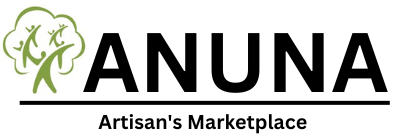TANJORE PAINTING: A Royal Heritage of India
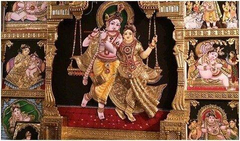
TANJORE PAINTING
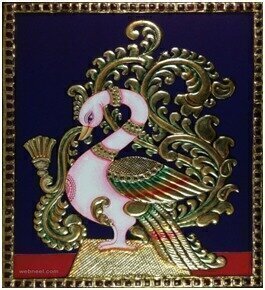
Tanjore or Thanjavur painting is a classical South Indian painting style, it is the native art form of Thanjavur which is also known as Tanjore city of Tamil Nadu. Tanjore paintings are deeply rooted to the art and culture of India.
'Religious paintings with a royal heritage', is the best definition for Thanjavur paintings, now better known as Tanjore paintings. These painting ranks among the greatest traditional art forms for which India is noted worldwide. Their themes are fundamentally mythological. These religious paintings demonstrate that spirituality is the essence of creative work.
Due to the dense composition, surface richness and vibrant colors, the Indian Thanjavur Paintings distinguished themselves from the other types of painting. Thanjavur paintings are characterized by rich and vivid colors, simple iconic composition, glittering gold foils overlaid on delicate but extensive gesso work and inlay of glass beads and pieces of very rarely precious and semi-precious gems. The liberal use of gold leaf and precious and semi-precious stones presents a splendid visual treat. They give life to the pictures such that the pictures come alive in a unique way. The relief work which is done gives them a three-dimensional effect.Tanjore painting is the foremost which is globally acclaimed for its indigenousness and unique way of creating a 3D effect on every single artwork.
Adorned with rubies, diamonds, and other precious gemstones, and trimmed with gold foil, Tanjore paintings were true treasures. Nowadays, however, semi-precious stones are used in place of real ones, but the use of gold foil has not altered. The shine and glean on the gold leaves used by the Tanjore style paintings, lasts forever.
In Thanjavur paintings one can see the influence of Deccani, Vijayanagar, Maratha and even European or Company styles of painting. Essentially serving as devotional icons, the subjects of most paintings are Hindu Gods, Goddesses, and Saints. Thanjavur paintings are panel paintings done on wooden planks, and hence referred to as Palagai Padam (palagai = "wooden plank"; padam = "picture") in local parlance.
The Government Museum, Chennai and the Thanjavur Art Gallery,Thanjavur also house fine collections of Thanjavur paintings depicting the Maratha kings of Thanjavur and other allied subjects. Many private museums and collectors also possess enviable collections of Thanjavur paintings.
The British and Victoria & Albert museums in England also house a large collection of Thanjavur paintings in the company and traditional styles. The National Museum of Copenhagen also houses a fine collection of 17th century Thanjavur paintings. King Christian IV of Denmark had received permission to build a fort at Tranquebar (Tharangambadi in Tamil) which led to the building of the Danesborg fort as also a Danish relationship with Thanjavur which resulted in the museum collection.
Tanjore paintings were painted by 'Moochys or Artists of India' according to the British chronicler Charles Gold in his book ‘Oriental Drawings’, published in 1806. Traditionally, it is well known that the Raju community of Thanjavur and Tiruchi, also called as Jinigara or Chitragara and the Naidu community of Madurai were the artists who executed paintings in the Thanjavur style. The artists (Rajus & Naidus) were originally Telugu speaking people from the artistically vibrant "Rayalseema" region of Andhra, who moved to Tamil Nadu in the wake of the fall of the Vijayanagar empire and the establishment of Nayak rule in Madurai and Thanjavur.The artists turned out a wide repertoire of paintings on different subjects and of varied quality depending upon the patron's interest, urgency and most importantly influence and financial capacity. However, the art was by and large a sacred task to be performed with a reasonable degree of ritual purity and humility by the master craftsmen, many of whom chose to remain anonymous and never signed their paintings, true to the Indian artistic tradition. However, a few works signed by the Thanjavur artists are also known. C. Kondiah Raju, the famous calendar artist from Kovilpatti, was one of the illustrious descendants to make a name as an artist during modern times from the Raju community.
In modern times, these paintings have become souvenirs for festive occasions in South India, colorful pieces of art to decorate walls, and collectors' items for art lovers. Tanjore Paintings are used to adorn the walls of houses and are even given as a gift to the near and dear ones during auspicious occasions, family gathering and celebrations like such as weddings, anniversaries, and birthdays.
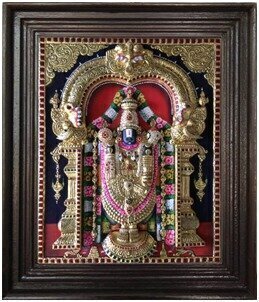
Glorious History of Tanjore Paintings-
The art form draws its immediate resources and inspiration from way back about 1600 AD, a period when the Nayakas of Thanjavur under the suzerainty of the Vijayanagara Rayas encouraged art—chiefly, classical dance and music—as well as literature, both in Telugu and Tamil and painting of chiefly Hindu religious subjects in temples. It is distinguished by its famous gold coating. However, it can safely be surmised that Thanjavur painting, as we know it now, originated in the Maratha court of Thanjavur (1676–1855). It has been recognized as a Geographical indication by the Government of India in 2007-08.
Tanjore Painting in India originated during the 16th century, during the rule of the Great Cholas. An extraordinary visual amalgamation of both art and craft, Tanjore paintings mainly consist of themes on Hindu Gods and Goddesses, with figures of Lord Krishna in various poses and depicting various stages of his life being the favorite. The unbeatable Maratha princes, Nayakas, Rajus communities of Tanjore and Trichy, while the Naidus of Madurai also patronized Indian Thanjavur Paintings from 16th to 18th century.
Thanjavur has a unique place in the history of Indian painting, in that it houses the Chola wall paintings in the Brihadeeswarar temple (Periya koyil or Pervudaiyar koyil in Tamil) as also paintings from the Nayak period (many times superimposed on the earlier Chola paintings) dating to the 16th century. The fall of the Vijayanagar Empire and the sack of Hampi in the Battle of Talikota in 1565 CE resulted in the migration of painters who had been dependent on the patronage of the empire. Some of them migrated to Thanjavur and worked under the patronage of the Thanjavur Nayakas. Subsequently, the Maratha rulers who defeated the Thanjavur Nayakas began to nurture the Thanjavur atelier. The artists absorbed the local influences and the individual tastes of their Maratha patrons which helped evolve the unique Thanjavur style of painting. The Thanjavur artists in addition to decorating temples also began painting and decorating the major buildings, palaces, chatrams and residences of the Maratha kings and nobility.
After the Maratha rule waned, the mercantile Chettiar community continued to patronize the Thanjavur artists. The Chettiars being staunch Shaivites encouraged Shaivite themes. One of their monasteries in Koviloor has large Thanjavur paintings on the lives of the 63 Nayanmars (Saivaite saints) and the 64 miracles (Thiruvilaiyadal Puranam) of Lord Shiva minutely labelled in Tamil.Similarly, the Bhimarajagoswami monastery in Thanjavur has a large painting of 108 Vishnu temples.
The direct European impact on Tanjore paintings began with the stationing of a British garrison in Thanjavur in 1773, during the Anglo-Mysore Wars of 1767–99. The Britishers who had come into Thanjavur in the wake of the Anglo-Mysore wars also patronized Thanjavur artists and their paintings.Throughout the nineteenth century, artists based in and around Thanjavur prepared, by and large a standard set of paintings for the Company personnel. These sets were called albums or album paintings and were a collection of 'native' or 'Indian' subjects of interest, suited to the English sensibilities and tastes. Common subjects were Gods and Goddesses, episodes from Hindu mythology; Fairs, ceremonies, processions, and festivals; Castes, their occupations, and dresses; Indian Flora and Fauna, etc. These paintings were executed by the same Tanjore artists in a style suited to western tastes. The paintings were usually executed on European paper, without gesso work, little or no Gold foil and without any glass or gem inlay. The paintings would also carry a brief description of the subject in English and sometimes in Tamil or Telugu. Paintings on cloth backed by wooden panels were also executed for the English patrons. Many of these were carried to England where they probably enlivened many an evening tea! The British Museum and The Victoria and Albert Museum have an enviable collection of such paintings.
Themes & Sources of Inspiration-
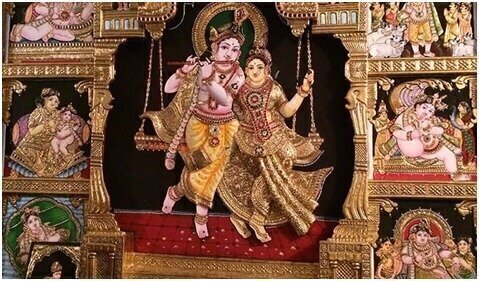
Tanjore paintings are being inspired by classical dance, music, and literature. The themes of the painting are of Hindu deities, figures, birds, flowers, animals, and saints. Most of Tanjore paintings revolve usually around the theme of Hindu Gods and Goddesses who are along with saints. In these paintings the main figure is always painted at the center of the painting. One of the distinguishable features of Tanjore painting is the plumpness in the faces of the idols which exudes the characteristic pristine look in all the Tanjore paintings you will come across.
Episodes from Hindu Puranas, Sthala-puranas and other religious texts were visualized, sketched, or traced and painted with the main figure or figures placed in the central section of the picture (mostly within an architecturally delineated space such as a mantapa or prabhavali) surrounded by several subsidiary figures, themes, and subjects. A typical Tanjore painting consists of one main figure, usually a deity, with a well-rounded face, body, and oval shaped eyes. The main figure would be enclosed using arches, curtains etc.
There are also many instances when Jain, Sikh, Muslim, other religious and even secular subjects were depicted in Tanjore paintings.
The painters of this ethnic art form take great care in making the relief work of each portrait which gives them the unique 3D effect. Such paintings are used as gift items on various occasions as Diwali, Pongal, weddings and so on. They are also used as home décor for residential houses and corporate offices. The generous use of vibrant colors, brilliant gems and splashes of gold leaves a glowing impact in the darkness of a room.
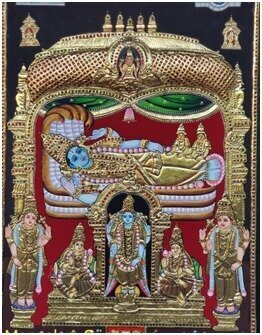
Making Process of a Masterpiece-
The making of a magnum opus involves several steps and the most challenging of all is creating the canvas.Tanjore paintings are always created by a team of artisans consisting of an experienced embosser, a visage impressionist, 22 carat gold leaf guilder and a master artist who focuses on painting the faces with the correct expressions.
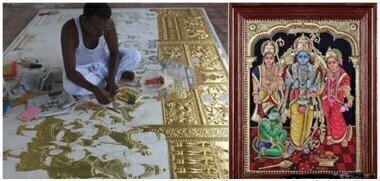
Steps involved in the making of the Tanjore Painting are:
- First, it is the drawing of the preliminary sketch of the image which is imagined on the base. The base is made up of a cloth usually muslin cloth, which is being pasted over a wooden base.
- The second step is to mix chalk powder or zinc oxide with Arabic gum and water-soluble adhesive make a muck paste. The fixative is applied on a thin muslin cloth and pasted on the wooden plank.
- Thereafter, the layout which was made at the first step of the artwork making is gradually and meticulously decked with various add-ons. The usual materials used for the beautification of a Tanjore painting are cut glass, semi-precious gems, rich colors, and laces. To augment the gorgeous effect of the painting, 22 Carat gold foils are pasted in different parts of a figure while the rest of the areas are filled with day-glow colors that match up with the brilliance of the painting.
Due to use of premier quality gold foil, an authentic Tanjore painting can last for generations without getting tarnished and a medium sized painting would be on a little expensive side as compared to that of the others.
Creating a work of genius is never an easy task and Tanjore painters have testified this fact down the generations. Such paintings require a good deal of your passion, perseverance, and perfection. Only when these three ‘P’s combine together can one produce such timeless creations. It may take between three to six months by an artist to make an authentic Tanjore painting.To sum up, Tanjore painting is the ultimate way of expressing devotion, truth, and skill by an artist through his/her creation.
The frames (teak wood) used for Tanjore paintings are of two types:
1. The wooden type, wherein plain type of wood is used.
2. The Chettinad type, which are more ornamental with designs.
Instead of breakable glass, "transparent acrylic sheets" are used to avoid breakage during transit.
At its peak, Tanjore paintings made use of diamonds, sapphires, and rubies as embellishments.In today’s day, it is impossible to use the rich materials that were originally used since that raises the cost of production immensely. Therefore, cost-effective substitutes such as plywood, synthetic colors and industrial adhesive are now being used.In the past, artists used natural colors like vegetable and mineral dyes, whereas the present-day artists use chemical paints.
Tanjore Art in Modern Times:
Tanjore paintings continue to be made even to the present day, though not with the rigor and virtuosity that marked the paintings of yore. 'Revival' programs, Exhibitions,Workshops and Training camps on Thanjavur paintings are being held regularly by many institutions including State Governments.
The materials used have also changed according to the cost, ease of availability and the choice of individual artists. Plywood, for example has by and large replaced Jack and teak wood. Synthetic colors and adhesives are preferred over the natural and mineral colors and other traditional components. Muck powder, a fine powder of chalk, is also used to create a 3D effect in the paintings. In addition to the traditional subjects, a wide range of popular and modern subjects and themes are being depicted in Thanjavur paintings.
Artists have taken this old form of art and over the years combined it with other styles to create mixed media arts. For example, Tanjores are also done on mirrors, sarees, glass, and canvas. The idea of applying gold foil is unique to this traditional art, so this same style is taken and recreated on different mediums.
Tanjore paintings have been adapted onto some of the richest, most artsy looking sarees in the South. Making use of high-quality silk, these paintings have been ‘printed’ onto the fabric rather than painted. Since these sarees are meant for formal and not festive occasions, they cannot be decorated with gold foil or precious and semi-precious stones (or their substitutes). Instead, the same effects and appearance has been retained in the form of rich prints.
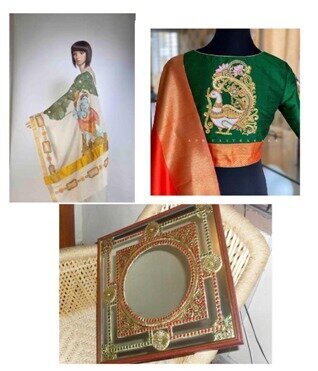
While it is a happy development that this traditional art continues to hold its sway, the brazen commercialization and lack of aesthetics are disturbing trends. Be that as it may, Thanjavur paintings – the style and aesthetics continue to inspire many contemporary artists. The Calendar prints of famous C. Kondiah Raju and his student followers, marked by an iconic solidness is an example of the continued influence of Tanjore paintings in modern, popular, and academic art.
Modern day Tanjore Paintings are becoming very much famous all over the world. Tanjore Paintings have become very much inspiring in the modern times. In this hectic world such painting provides peace to those who own them and those who make them. It has become even motivational therapy for peace. With the changing times and eras, the Tanjore paintings have seen transformation in their painting art and painting prints.
 1,12,000 Artisans families benefited so far
1,12,000 Artisans families benefited so far